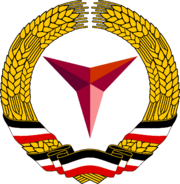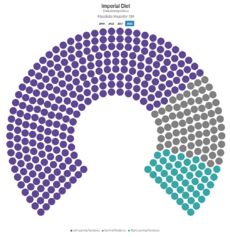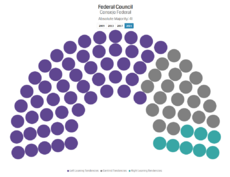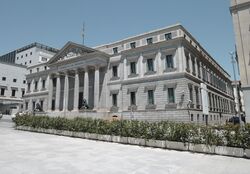Parliament of Eothasia: Difference between revisions
No edit summary |
No edit summary |
||
| Line 10: | Line 10: | ||
| leader1_type = Queen of the Realm | | leader1_type = Queen of the Realm | ||
| leader1 = Marina Neumann | | leader1 = Marina Neumann | ||
| election1 = '''Election:''' | | election1 = '''Election:''' 13 April 2014 | ||
| leader2_type = Federal President | | leader2_type = Federal President | ||
| leader2 = Valerius Eäron | | leader2 = Valerius Eäron | ||
| election2 = '''Election:''' 1 January | | election2 = '''Election:''' 1 January 2017 | ||
| leader3_type = Federal Chancellor | | leader3_type = Federal Chancellor | ||
| leader3 = Manfred Leitzke | | leader3 = Manfred Leitzke | ||
| election3 = '''Election:''' 1 January | | election3 = '''Election:''' 1 January 2017 | ||
| leader4_type = President of the Federal Diet | | leader4_type = President of the Federal Diet | ||
| leader4 = Senator Léonard Lachapelle | | leader4 = Senator Léonard Lachapelle | ||
Revision as of 12:01, 11 April 2020
| Cortesreich | |
|---|---|
| (LXXXIX Cortes) | |
 | |
| Type | |
| Type | |
| Leadership | |
Queen of the Realm | Marina Neumann since Election: 13 April 2014 |
Federal President | Valerius Eäron since Election: 1 January 2017 |
Federal Chancellor | Manfred Leitzke since Election: 1 January 2017 |
President of the Federal Diet | Senator Léonard Lachapelle since May 5th, 2017 |
President of the Federal Council | Councillor Zella Lorentz |
| Structure | |
| Seats | 387 senators—81 councilors |
 | |
Federal Diet political groups | Left Wing Tendency [270] Centrist Tendency [71] Right Wing Tendency [46] |
 | |
Federal Council political groups | Left Wing Tendency [51] Centrist Tendency [21] Right Wing Tendency [8] |
| Elections | |
| uninominal | |
| plurinominal | |
Federal Diet last election | May 4, 2017 |
Federal Council last election | May 4, 2017 |
| Meeting place | |
 | |
| Capitolium, Wyzim, Eothasia | |
The Federal Courts [Eothasi: Cortesreiches] is the legislative branch of the Crowned Federal Republic of Eothasia. It is a bicameral organism composed by the chamber of the Federal Diet, which acts as the lower house, and the Federal Council, which acts as the upper house.
The Federal Diet is a uninominal constituencies system. The entire country is divided into 387 constituencies; each constituency proposes one candidate to the Federal Diet, which will act as that constituencies’ particular representation in this body. As such, all members are independents and there are no parties in the Eothasi political system. In order to ensure that not only higher-class individuals are able to attempt election due to the costs of the electoral campaigns, the federal government has ensured the following rules: (1) candidates for elections must not draw funds for their campaigns from personal accounts, but exclusively from donations of members that must reside within the region that they represent; (2) the ruling government of the Popular Republic to which a specific constituencies belongs must ensure that local debates are conducted to ensure visibility of all candidates; (3) small subsidies are provided to candidates in a second consecutive candidacy. Members of the Federal Diet are voted directly by the citizens of the country. These elections occur once every five years and the entirety of the Federal Diet is up for vote at the same time.
Meanwhile, the Federal Council is a space for representatives of the different governments of the country. Each of the seven Popular Republics is divided into a number of provinces which total 26 between the seven of them, plus the state of Wyzim for a total of 27 represented states in the Federal Council. Each of these provinces selects three candidates to participate in the Federal Council as councilors and represent the interests of their respective provinces in the upper house of the legislative branch. As such, the Federal Council consists of a total of 81 selected members; these members are selected by the government of the Popular Republic for which the Province State pertains; as such, regions like Espinar have a total of only six representatives, Wyzim has three representatives, whereas Aterni has eighteen representatives and Venza another fifteen. As it stands, the current distribution of Provincial States and representatives is as follows:
| Popular Republic | Federal Councillors |
|---|---|
| Aterni | 18 |
| Venza | 15 |
| Antizon | 12 |
| Mariser | 12 |
| Volsini | 9 |
| Elvira | 6 |
| Espinar | 6 |
| Wyzim | 3 |
While the Federal Diet has an established Presidency of the Diet which presides over the chamber, the Federal Council is instead presided by the Federal Government, which hears the interests of all involved parties and acts in accordance with their necessities. That said, the Circle of Governance appoints a President of the Federal Council to act as its liaison to the upper house.
History
Following the end of the conquest of the Eothasi peninsula by the Aterni Empire, the country experienced years of incredible economic growth and military prowess, demonstrating to various countries across the world the might of the imperial military. However, there were deep social problems embedded in the country, as the Eothasi government was largely representative of the interests of the original Aterni territory instead of the whole of Eothasia. This changed with Empress Duvaineth.
Empress Duvaineth rose to power in 1674 and was the first empress to actively advocate for the elimination of the Eothasi monarchy. Though it was a popular move within the Eothasi populace as a whole, the citizens of the Aterni Empire believed it was a diminishing of the power that was rightfully theirs as conquerors of the peninsula. Despite this, Empress Duvaineth eventually proceeded to found the First Eothasi Republic, also known as the Union of Eothasi Republics, which was a unitary parliamentary republic.
This was the first introduction of the modern system of legislative branch existent today in the Repúblikenreich. However, because of the social tensions in the beginning of the 20th Century that advocated for a socialist movement, the exact system was changed with the Popular Constitution of 1913. In this system, the legislative branch was changed: instead of being unicameral, it would recuperate the bicameral structure, thus representing both the will of the people and the territorial necessities of the country. This eventually established the current structure of the Federal Courts.
Though there have only been 27 Federal Courts and 62 Republic Courts, the official count of the Federal Courts sums both of these. As such, the incumbent legislature is known as the 89th Federal Courts.
In the late 17th Century, after the official selection of Wyzim as the capital of the newly formed Union of Eothasi Republics, the construction of the Capitolium —the building where, to this day, the Federal Courts convene for sessions— began. It was completed by 1701 and the first session was held in May 10, 1701 by the 6th Federal Courts.
Privileges and Pay
Privileges
Members of the Federal Courts have a series of privileges due to their position within the Eothasi government. These include freedom from arrest except in cases of treason, felony, and disturbance of the peace.
Pay
The gross salary of all members of the Federal Courts is 53.956,18ℭ. This does not include commissions (such as those for the President of the Federal Diet, which receives an amount close to 30.000,00ℭ). There are also a series of indemnizations for distance (the members of the Federal Courts that are from regions farthest away from Wyzim receive more than those closer to the capital).